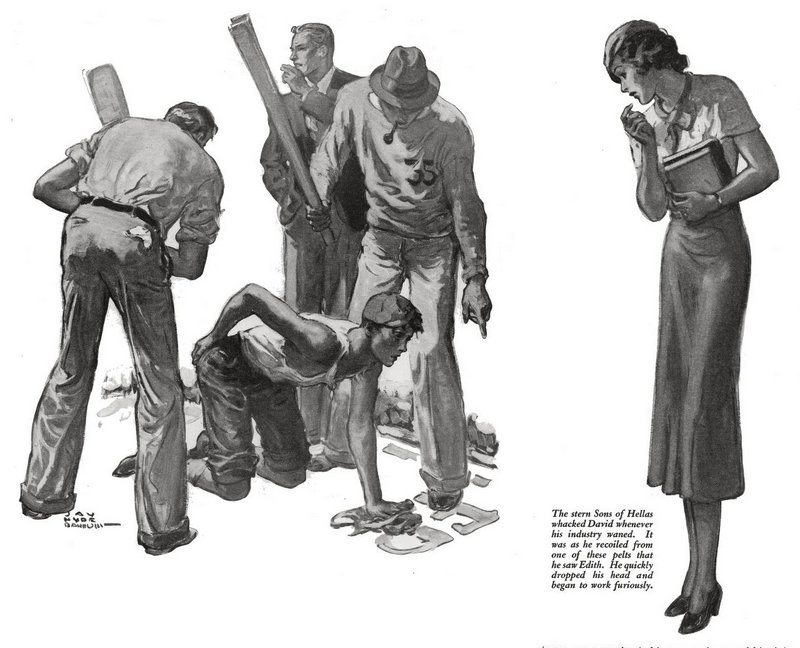A Tragic Hazing
Here at Spanking Blog I have tended to make light of hazing scenarios, whether fraternal or sororal, because they often work so well as a fantasy framework. But it’s perhaps worth pausing once in a while to emphasize that outside our fantasy context, hazing is just a fancy word for bullying. And bullying can have the most tragic consequences.

I was surprised that the story illustrated by the above artwork took such a strong line against hazing, considering that it appeared in the November 1934 issue of Cosmopolitan. My historical education, such as it has been, made me think that hazing was broadly considered harmless in that era. And perhaps that was, indeed, the mainstream thrust of opinion. But this story goes another way. In Autumn Idyl, our hero arrives at a California university with what we would now call post-traumatic stress from a family history of fatal mob violence against his father. The escalating hazing condoned at his institution — all of it completely non-consensual, not fraternity rushing he volunteered for, just ritual violence directed at freshmen in general — eventually pushes him past a psychological limit, triggering his commission of a violent act of self-defense that nonetheless gets him expelled.




I think your belief that hazing was considered more or less harmless in that era is correct. And during the first half of the 20th century, it probably was fairly benign although the sheer ignorance and ineptitude of collegiate paddlers certainly resulted in some too-severe paddling. (Wood paddles are wonderful implements, but you have to know what you’re doing to use them properly and safely. Super-hard baseball-type swings are a definite no-no.) But things began to change for the worse – I will guess this happened in the 70s and rapidly went downhill from there – as American society began to suffer from the cultural assault that began in the 60s.
As morals declined generally, there were fewer internal restraints on those doing the hazing and they started doing some terrible things to their pledges. Why did nobody stop them? It’s a sad fact of human nature that when a group is doing something wrong, very few people have the courage to go against the group and step up and say, “This is wrong” even though they know it is. That is even more true with young people who want to fit in with the group.
I’ve never cared for hazing, but there is a difference between making someone push a peanut along the floor with his nose and, say, forcing him to drink a dangerous amount of alcohol. I don’t think most of people doing the hazing back in the 30s, 40s, and 50s had any bad intentions, but eventually the times became safe for bullies to come out into the open.
In the early-1960’s there were kinds of hazing that were dangerous in at least one traditional, prestigious college, like rolling drunken (?) kids down a hill in a barrel. It wasn’t meant to be harmful, but it’s a bad experience.
The 1957 movie Sorority girl portrays sorority “hazing” as mistreatment in a way that reminds me of the “Autumn Idyl” story.
Probably there was no consensus that hazing was harmless per se in the first half of the 20th century. Rather, even then it must have been considered one optional part of college life, along with heavy drinking and parties, and looked at similarly by society. In the 1920’s, there was Prohibition, and although that was repealed, there still must have been quite a few opponents of alcohol consumption. And those same people would probably not really be happy about other “wild” aspects of college life. Further, alcohol in many states was banned for anyone under 21. So in those cases society might have turned a blind eye to college fraternity drinking, but did not necessarily approve.
Probably the most common opinion would have been that standard hazing, heavy drinking, parties, and other parts of frat life were okay if they were consensual, and not okay if a person was forced into it. In typical frat hazing, the pledges were volunteering for initiation. But in the Autumn Idyl story and “Sorority Girl” movie, the person was not consenting to the hazing or desiring it, so the hazing would have been breaking the most common social opinion on the topic.
Considering the vast number of frats in the nation in the 1930’s-1950’s and the fact that they had heavy drinking, there is no reason for me to think that as a rule practically no frats were abusive even by the standards of that time. Even if only 10 percent of frats were abusive (whatever the bar for abuse was), it would still be significant.
The other thing to consider is that cases of actual abuse might have been kept under wraps better because there was no internet to spread information. In my college time in the 1990’s, it was common for frats at my college to say that they don’t haze, but it’s hard to know how true that is if you aren’t on the inside. One frat that got closed down by the college had a reputation for wild hazing. One rumor involves sex with animals. A student from another frat than that one had a burn mark on his arm, and when I asked him where he got it, he said it was from his frat.